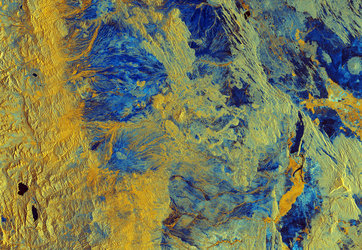Accept all cookies Accept only essential cookies See our Cookie Notice

About ESA
The European Space Agency (ESA) is Europe’s gateway to space. Its mission is to shape the development of Europe’s space capability and ensure that investment in space continues to deliver benefits to the citizens of Europe and the world.
Highlights
ESA - United space in Europe
This is ESA ESA facts Member States & Cooperating States Funding Director General Top management For Member State Delegations European vision European Space Policy ESA & EU Responsibility & Sustainability Annual Report Calendar of meetings Corporate newsEstablishments & sites
ESA Headquarters ESA ESTEC ESA ESOC ESA ESRIN ESA EAC ESA ESAC Europe's Spaceport ESA ESEC ESA ECSAT Brussels Office Washington OfficeWorking with ESA
Business with ESA ESA Commercialisation Gateway Law at ESA Careers Cyber resilience at ESA IT at ESA Newsroom Partnerships Merchandising Licence Education Open Space Innovation Platform Integrity and Reporting Administrative Tribunal Health and SafetyMore about ESA
History ESA Historical Archives Exhibitions Publications Art & Culture ESA Merchandise Kids Diversity ESA Brand Centre ESA ChampionsLatest
Space in Member States
Find out more about space activities in our 23 Member States, and understand how ESA works together with their national agencies, institutions and organisations.
Science & Exploration
Exploring our Solar System and unlocking the secrets of the Universe
Go to topicAstronauts
Missions
Juice Euclid Webb Solar Orbiter BepiColombo Gaia ExoMars Cheops Exoplanet missions More missionsActivities
International Space Station Orion service module Gateway Concordia Caves & Pangaea BenefitsLatest
Space Safety
Protecting life and infrastructure on Earth and in orbit
Go to topicAsteroids
Asteroids and Planetary Defence Asteroid danger explained Flyeye telescope: asteroid detection Hera mission: asteroid deflection Near-Earth Object Coordination CentreSpace junk
About space debris Space debris by the numbers Space Environment Report In space refuelling, refurbishing and removingSafety from space
Clean Space ecodesign Zero Debris Technologies Space for Earth Supporting Sustainable DevelopmentLatest
Applications
Using space to benefit citizens and meet future challenges on Earth
Go to topicObserving the Earth
Observing the Earth Future EO Copernicus Meteorology Space for our climate Satellite missionsCommercialisation
ESA Commercialisation Gateway Open Space Innovation Platform Business Incubation ESA Space SolutionsLatest
Enabling & Support
Making space accessible and developing the technologies for the future
Go to topicBuilding missions
Space Engineering and Technology Test centre Laboratories Concurrent Design Facility Preparing for the future Shaping the Future Discovery and Preparation Advanced Concepts TeamSpace transportation
Space Transportation Ariane Vega Space Rider Future space transportation Boost! Europe's Spaceport Launches from Europe's Spaceport from 2012Latest
Earth from Space: Central Ethiopia
Thank you for liking
You have already liked this page, you can only like it once!
The Copernicus Sentinel-1 mission brings us a false-colour radar image of central Ethiopia.
Zoom in to explore this image at its full resolution or click on the circles to learn more.
The depicted area spans 600 km in length and 500 km in width, covering a significant portion of central Ethiopia. It includes multiple Sentinel-1 images from spring, summer and autumn 2023, which have been overlaid to create this single image.
Radar images capture surface texture rather than reflected light so they are naturally black and white but here images from each season have been assigned a different colour: red, green and blue respectively. When the images are combined, the different colours reveal variations that occurred in the different seasons.
Built-up areas and constructions are easy to identify as they usually appear as bright patches. Ethiopia’s capital, Addis Ababa, visible in the top right, stands out as does the black outline of the international airport to the south of the city.
Ethiopia’s terrain is one of the most rugged in Africa. South from Addis Ababa, the Main Ethiopian Rift traverses the middle of the image, featuring chain of volcanoes, faults and Ethiopia’s Lakes Region. The valley holds many small rivers that drain into several lakes, with the largest captured in the image being Lake Abaya. These lakes cover more than 3108 sq km.
While radar is particularly useful for picking out relief, water bodies show up dark because flat water surfaces reflect the radar signal away from the satellite. The various colours visible in some lakes are due either to the changing surface currents and sediments from rivers or to variations in water level.
At the bottom of the image, Lake Turkana (left) and Lake Chew Bahir (right) show different shades of colours because of alternating water levels. Different colours can also be seen along the Omo River delta, which enters Lake Turkana from the north. The basin, which results from the Gilgel Gibe III Dam blocking the river water flow, can be seen as a black feature resembling a lizard in the centre of the image.
-
CREDIT
contains modified Copernicus Sentinel data (2023), processed by ESA -
LICENCE
CC BY-SA 3.0 IGO or ESA Standard Licence
(content can be used under either licence)

Lake Tana, Ethiopia - ASAR - 31 March 2004

Northeast Ethiopia

Earth from Space: Ethiopian painting

Earth from Space: Northeast Ethiopia















 Germany
Germany
 Austria
Austria
 Belgium
Belgium
 Denmark
Denmark
 Spain
Spain
 Estonia
Estonia
 Finland
Finland
 France
France
 Greece
Greece
 Hungary
Hungary
 Ireland
Ireland
 Italy
Italy
 Luxembourg
Luxembourg
 Norway
Norway
 The Netherlands
The Netherlands
 Poland
Poland
 Portugal
Portugal
 Czechia
Czechia
 Romania
Romania
 United Kingdom
United Kingdom
 Slovenia
Slovenia
 Sweden
Sweden
 Switzerland
Switzerland
























